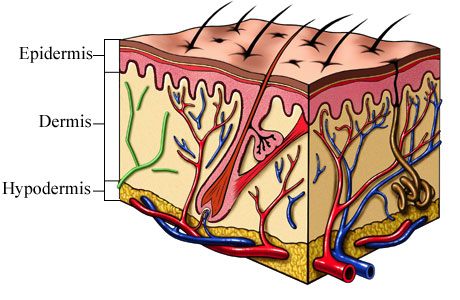Today, I’m going to talk about the skin barrier. I’m going to define what it is, and why it plays an important role in the health of our skin.
First of all, when you think of your organs, you probably think: heart, lungs, liver, kidneys … generally you don’t think of your skin as an organ – but your skin is an organ — in fact, it is your body’s largest organ. Your skin is a reflection of the health of your body – if your body is not healthy on the inside, it is reflected in the appearance of your skin on the outside. As well, the healthier your skin is on the outside, the better job it can do to protect your insides.
Your skin actually is made up of three distinct layers: subcutaneous (or Hypodermis, as shown above), dermis, and epidermis. The subcutaneous or subcutis layer is the lowest layer. The subcutaneous layer (sub means under and cutis means skin) is the fatty layer that provides protection and cushioning between the skin and muscle layers. The dermis makes up a large portion of the skin, and is the layer between the subcutaneous and the epidermis. The dermis is where collagen and elastin are formed.
The epidermis is the outer layers of the skin, and is actually divided into several different sections, including the basal layer, which lays right on top of the dermis and is where new cells are formed. These cells that are formed in the basal layer continue to multiply and migrate upward toward the surface of the skin.
The very outermost layer of the epidermis, the skin surface, is called stratum corneum, or the skin barrier. The stratum corneum, or skin barrier, is actually made up of 7-10 layers of dead skin cells – cells that began in the basal layer and migrated to the surface of the epidermis. It’s a process that normally takes about 26-32 days in normal, healthy, young skin. Those dead skin cells are stacked on top of each other and held together at the skin surface with a substance called intercellular lipids. You may think of scales on a fish, for example, or another common comparison is bricks and mortar, which are the cells and lipids held together.
Even though these skin cells in the skin barrier are technically not living cells, they do play an important role in protecting your skin from outer bacteria and viruses. As well, your skin barrier also holds water inside your body to protect your body from losing water (also known as trans-epidermal water loss, or TEWL). Our adult bodies are actually about 60-70% water, so if you didn’t have these outer layers of skin barrier keeping water inside your body, you would literally dry up in a few hours, like a piece of dehydrated fruit!
Why is it important to keep your skin barrier healthy?
As we age, our skin barrier breaks down and our epidermis thins after constant exposure to environmental factors. It’s not just a matter of looking good on the outside; a healthy, intact skin barrier protects you from environmental factors that contribute to visible skin aging and skin diseases. A thinner epidermis due to exposure influences the breakdown of collagen and elastin in the dermis, which causes us to sag and wrinkle. Things like sun exposure, pollution, topical prescriptions, stress and even strong ingredients such as alpha-hydroxy acids or retinols can affect the health of your skin barrier.
When you make a skin care product decision, remember to choose products that are proven to safely help repair and fortify your skin barrier, to keep your largest organ, your skin, at its healthiest. A healthy skin barrier is your protective shield against the harsh elements of the outside world.
* Image used from image.google.com accessed on 11/04/2008.
